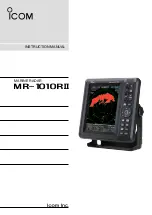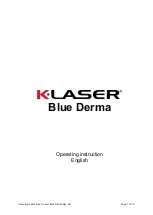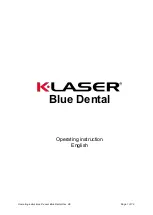
Sea Recovery Ultra Whisper Rev. A
Helpful Terms to become familiar with:
A. OSMOTIC PRESSURE:
The transfer of the water
from one side of the membrane to the other will
continue until the head (pressure) is great enough to
prevent any net transfer of the solvent (water) to
the more concentrated (feed water) solution. At
equilibrium, the quantity of water passing in either
direction is equal, and the head pressure is then
defined as the
”Osmotic Pressure”
of the solution
having that particular concentration of dissolved
solids.
B. SPIRAL-WOUND MEMBRANE:
The spiral-wound
membrane consists of multiple membrane envelopes
each formed by enclosing a channelized product
water carrying material between two large flat
membrane sheets. The membrane envelope is sealed
on three edges with a special adhesive and attached
with the adhesive to a small diameter pipe. A
polypropylene screen is used to form the feed water
channel between the membrane envelopes. A wrap
is applied to the membrane element to maintain the
cylindrical configuration. The center tube is also the
permeate (product water) collecting channel.
Several elements may be connected in series within a
single or multiple pressure vessel(s).
C. BOUNDARY LAYER / CONCENTRATION
POLARIZATION:
When water permeates through
the membrane, nearly all the salt is left behind in
the brine channel. In any dynamic hydraulic
system, the fluid adjacent to the wall of the vessel is
moving relatively slowly. Even though the main
body of the stream is turbulent, a thin film adjacent
to the wall (membrane) is laminar. This thin film is
called the boundary layer. At the boundary layer
the salts are saturated and can readily adhere to and
pack into the R.O. Membrane Element surface if the
Feed Water Flow is insufficient to prevent this.
For this reason it is important to maintain sufficient
Feed Water flow, to prevent Concentration
Polarization, through the R.O. Membrane Element.
The Sea Recovery ETD chambers are designed to
travel in shorter and more frequent strokes than
other such enhancers in use. This minimizes the
potential for Concentration Polarization.
D. COMPACTION:
Some densification of the membrane
structure may take place while operating at elevated
pressures, above 1000 PSI. The change is known as
compaction and is accompanied by a reduction in
the water permeation rate. When the R.O.
Membrane Element is subjected to elevated
pressures beyond 1000 PSI the Product Water
Channel becomes squeezed which results in
restriction and in turn product water recovery
reduction.
E. WATER TEMPERATURE EFFECT:
The product
water flow through the membrane is significantly
affected by the water temperature. At any given
pressure this flow increases with increasing water
temperature and is reduced at lower temperatures.
The Ultra Whisper System over comes this factor by
self adjusting the operating pressure to maintain a
precise amount of Product Water Flow.
F. PRESSURE:
The operating pressure has a direct
affect on product water quality and quantity. Both
factors will increase as the system pressure increases
(higher quantity and higher {better} quality within
design limits). The system must be operated at the
lowest pressure required to achieve the designed
product water flow rate. This parameter also
minimizes compaction, which proceeds at a faster
rate at higher pressures as well as at higher
temperatures. The Ultra Whisper System self
adjusts its operating pressure to maintain a precise
amount of Product Water Flow. However in so
doing, at low temperatures and or high salinity feed
water conditions the Ultra Whisper will operate at
higher than normal pressure in maintaining the
specified amount of product water flow. This is
normal, to be expected, and is due to the design
characteristics of the ETD [14].
G. BRINE VELOCITY:
The brine flow over the
membrane surface is very important to both product
water quality and quantity. At low flows,
concentration polarization occurs, causing the water
quality to decline. In addition to inferior product
water quality, low brine flows can increase the
precipitation of sparingly soluble salts which will
foul the R.O. Membrane Element [16] surface
(concentration polarization). If this occurs, the
product water flux (production) will decline. The
Ultra Whisper Feed Pump [6] and ETD [16]
integrated design provide a relatively smooth and
continual flow of Feed Water across and through the
R.O. Membrane Element [16].
H. ENERGY TRANSFER DEVICE (ETD) [14] or
ENHANCER:
Pressure from the Feed Pump [6] into
the ETD is “enhanced” by the ETD by a ratio of
approximately 5:1 to 6:1; and the pressurized water
entering the Return Chamber of the ETD is
transferred as recovered energy back to the Inlet
Chamber. These two factors allow the Ultra
Section 1 Page 15 of 16
Summary of Contents for SRC Ultra Whisper Compact 200
Page 2: ......
Page 3: ...Ultra Whisper 200 600 Owner s Manual ...
Page 5: ...This page is intentionally blank ...
Page 11: ...Sea Recovery Ultra Whisper Rev A vi ...
Page 12: ...Sea Recovery Ultra Whisper Rev A vii ...
Page 14: ...Sea Recovery Ultra Whisper Rev A ix ...
Page 186: ...Sea Recovery Ultra Whisper Rev A Section 7 Maintenance Repair section 7 page 1 of 39 ...
Page 225: ...This page is intentionally blank ...
Page 251: ...Sea Recovery Ultra Whisper Rev July 2008 section 9 page 14 of 49 ...
Page 298: ......
Page 299: ......
















































